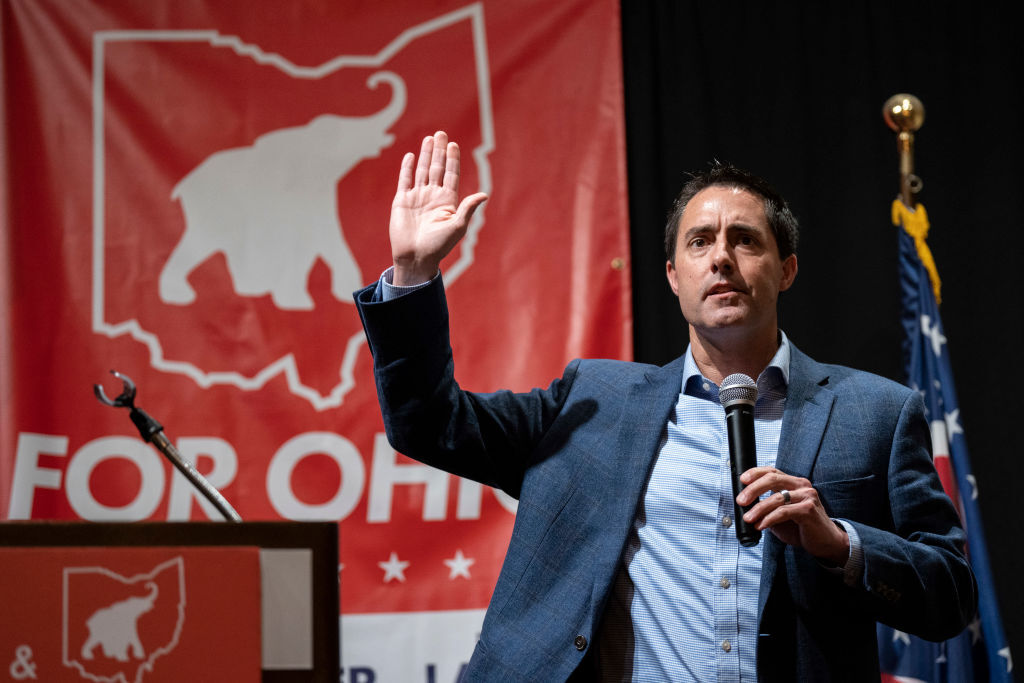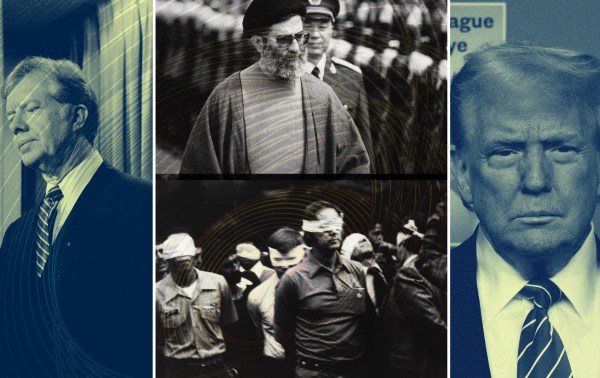Imagine what this country might look like if amendments to the U.S. Constitution could be enacted by simple majorities in national referendums.
The Supreme Court’s decision in Brown v. Board of Education desegregating public schools might have been overturned. Support for that ruling after it was issued was stronger than you might assume given the era, but at one point in the mid-1950s the public was split as narrowly as 52-44 in favor. A referendum held at the time to undo the decision could have gone either way.
Interracial marriage has been constitutionally protected since 1967, when the court decided Loving v. Virginia, but public support for the practice lagged for years afterward. As recently as the mid-1990s—no typo—a minority of Americans approved of marriages between whites and blacks. Loving too might have been undone at the polls.
In 1942, the court infamously upheld the federal government’s power to intern Japanese-Americans during wartime. But had that decision gone the other way, it’s a cinch that a national referendum would have overruled it. A poll taken that year found 59 percent of Americans supported forcibly removing U.S. citizens of Japanese descent from the West Coast.
The point of the Constitution is to limit the power of the federal government to encroach on the rights of the states and the power of all levels of government to encroach on the rights of the individual. Allowing the document to be amended directly by the voters who elected those governments in the first place would be perverse, permitting the sort of tyranny of the majority that it otherwise aims to prevent by cutting out the legislative middleman.
If we’re going to change the supreme law of the land, the document that safeguards the fundamental balance of power between state and citizen, we should logically require an unusually strong consensus to do so. A simple majority that would make the Constitution subject to popular whim is too meager. A supermajority, whether of the public or their elected representatives, is more sensible. Which is how we ended up with Article V.
All of this is a preface to saying that, in the abstract, I like what Republicans in Ohio are up to in seeking to raise the threshold for amending their state constitution. Currently that document can be amended by a 50-percent-plus-one vote in a ballot initiative, inviting a tyrannical majority to alter the supreme law of the state at the polls. Republican legislators want to raise the bar to 60 percent, more in line with the U.S. Constitution’s supermajority requirements.
But they’re not doing so for abstract philosophical beliefs about majority rule and minority rights. They have a particular outcome in mind. And in a post-liberal GOP, outcomes are everything.
Some Ohio Republicans have been coy about their sudden interest in raising the threshold for constitutional amendments. But not all.
The push began last November, a few months after the Supreme Court overturned Roe v. Wade. Ohio had a six-week abortion ban on the books but Republicans could look across the border and guess what might soon become of that law. On Election Night, amid sweeping Democratic victories in Michigan, voters there passed a referendum amending their own constitution in order to guarantee abortion rights. The share voting in favor was 56.7 percent.
Pro-choicers prevailed in other abortion-related ballot initiatives that day, including in red states. In Kentucky, their side won with 52.4 percent. But the most noteworthy referendum on the subject happened a few months earlier, in Kansas, when pro-choicers prevailed with 59 percent.
Go figure that Republicans in Ohio digested those results and concluded that, after 111 years of allowing simple majorities to pass new constitutional amendments at the polls, a 60 percent majority was suddenly necessary.
A few Republican legislators have gamely insisted that the timing is a coincidence and that the higher threshold is needed to prevent out-of-state “special interests” from meddling with Ohio’s constitution. But state Rep. Brian Stewart was candid in an email he sent to colleagues last December endorsing the 60 percent threshold: “After decades of Republicans’ work to make Ohio a pro-life state, the Left intends to write abortion on demand into Ohio’s Constitution. If they succeed, all the work we accomplished by multiple Republican majorities will be undone.”
He’s not wrong. Pro-choicers in Ohio are in fact gathering signatures for a new ballot referendum this November that would amend the state constitution to permit abortion until a fetus is viable, at around 24 weeks.
To head them off at the pass, the GOP’s own 60 percent amendment would go before voters for approval in August. The Ohio legislature had recently voted to eliminate special elections in August, a sleepy time of year with low turnout traditionally, but they’re making a special exception for this one at a cost of some $20 million. They have no choice: Obviously, the 60 percent amendment needs to be enacted before the pro-choice amendment is voted on in November.
If everything works out for Republicans, the 60 percent amendment might pass with 50.1 percent of the vote while the subsequent pro-choice amendment will fail with 59.9 percent.
The 60 percent amendment wouldn’t just raise the threshold for constitutional amendments. It would require activists seeking to add an issue to the ballot to gather a certain number of signatures in all 88 of Ohio’s counties instead of 44, as the law currently provides, which will make things tricky for progressives in deep-red rural areas. That signature provision won’t take effect until 2024 for legal reasons but it’s still tied to the long-term effort to keep abortion out of the state constitution. In case pro-choicers fall short in November, their next bite of the apple to enact abortion rights via a ballot initiative will be more difficult procedurally.
A bill supporting the 60 percent amendment passed the state Senate last week, with the House soon to take it up. On Wednesday Ohio’s Republican secretary of state warned house legislators of “consequences” from their voters if they fail to pass it.
They’re playing Calvinball, in short, tweaking the rules of the amendment process after it’s already begun to avert a policy outcome on abortion that they abhor.
How should someone who supports supermajority requirements for constitutional amendments in principle feel about this?
Despite the fact that I share the goal of reducing abortions, I don’t feel great. The move reeks of an attempt by the state representatives to protect their personal policy preferences from being overridden by … their own constituents. Voters.
Representatives are supposed to represent the will of the people. The effort underway in Ohio to raise the threshold for constitutional amendments is a product of Republican legislators deducing what a majority of the electorate wants on abortion and, instead of conceiving of ways to deliver it, contriving procedural roadblocks to thwart it. That’s not the way democracy is supposed to work.
The reason we typically require a supermajority to change a constitution is to make it harder for the majority, through its elected representatives, to target the rights of a vulnerable minority. In this case, though, the majority is pitted against its own representatives. They can’t convince the state legislature to enact a policy that a (likely) majority of residents prefers, so they’re taking matters into their own hands—only to find their own leaders trying to foil them by upending an amendment process that’s been good law for more than 100 years.
“Well, then the people should vote them out of office,” you might say, and I agree. If a representative won’t do what his constituents desire, the solution is to oust him in the next election. That’s how democracies ensure accountability.
But in an age of ruthless gerrymandering on both sides, accountability is easier said than done. Ohio broke 53-45 for Trump in the last presidential election yet the state Senate tilts 26-7 Republican and the state House leans 65-32 toward the GOP. The party enjoys supermajority power in both chambers. The only way to enact policies that a majority of voters support but which Republican lawmakers oppose is, therefore, a ballot initiative.
And soon that might carry a supermajority requirement too.
Put simply, the GOP’s ballot initiative seems designed less to protect minority rights than to facilitate minority rule in a hotly contested policy dispute which the minority is losing.
“They’re trying to protect the rights of the unborn minority,” you might counter, and I sympathize. But that’s the point of this debate, isn’t it? To decide which rights the unborn should have?
The end of Roe was supposed to return that question to the democratic process. Instead of embracing that process and offering their own amendment to enshrine unborn rights, Republicans in Ohio have undertaken to make the democratic process a bit less democratic than it was before.
Relatedly, there’s an important distinction between amending the U.S. Constitution and what’s happening in Ohio. The federal Constitution has an unusual degree of public legitimacy partly for procedural reasons: Its components were ratified by a supermajority of the states, reflecting a strong national consensus supporting each. We don’t allow simple legislative statutes to override that strong consensus. If you want to change the U.S. Constitution, you need to generate an unusually strong consensus of your own.
In Ohio, the six-week ban on abortion that passed there in 2019 was a simple statute, requiring only a bare majority to pass. Ohio voters now seeking to override that law via ballot initiative aren’t trying to substitute a weak consensus for a particularly strong one. They’re attempting to substitute one expression of simple majority will for another.
And in an America where federal constitutional rights protect citizens from state governments, there’s less to fear from a state majority abusing its power to amend its state constitution via simple majority. If Ohioans passed an amendment with 50.1 percent of the vote banning all religions but Christianity, that amendment would be headed down the toilet in federal court before close of business that day.
All in all, how I feel about what Ohio Republicans are doing is how I felt about Ron DeSantis seeking to eliminate Disney’s special improvement district in Florida. In the abstract I can see sound policy reasons to do it. It’s weird, frankly, for a private corporation to enact its own land-use rules through a government cut-out that it controls.
But DeSantis didn’t try to quash Disney’s district as a matter of good government. He did it to retaliate against the company for expressing a political opinion he disliked. Intentions matter. To endorse a defensible policy enacted for indefensible reasons is to encourage further indefensible reasoning.
If Ohio’s state legislature gets away with playing Calvinball on abortion, on which other subjects might legislatures begin playing Calvinball?
This, by the way, is what it looks like when a party gives up on persuasion.
In a state as red as Ohio has become, it’s not unthinkable that pro-lifers might win a ballot initiative on whether the constitution should protect abortion rights. Republicans there could have focused their energy not on raising procedural thresholds for amendments but on convincing undecided voters to support the six-week ban. Even if they failed, having the simple-majority threshold for amendments in place would allow them to repeal any newly enacted abortion rights in some future amendment after they’ve persuaded a majority of Ohioans to ban the practice.
They don’t think they can win, though. For all the populist blather about the “silent majority,” the right’s unspoken fear that they’ve lost the country and will continue to lose ground over time explains much Republican behavior in the Trump era. They lost the presidential popular vote twice, lost the House in 2018, lost the Senate in 2020, lost a bunch of winnable statewide races in 2022, and lost a series of state referendums on abortion post-Roe. A party that still believed itself capable of persuading voters wouldn’t be en route to renominating the guy who led them through those many disasters. A party that believes its only option is to brute-force its way to power, whether by ginning up base turnout on Election Day to overwhelm swing voters or through less legitimate means if it can’t, might understandably triple down on Trump.
That logic is at work in Ohio. “Republicans had three choices: make the case to voters that tough abortion restrictions were worthwhile; compromise and bend to public opinion; or change the rules so that their opponents could not protect abortion rights against the will of a legislature that wants to ban the procedure,” wrote liberal commentator Jamelle Bouie of the GOP’s dilemma there. There was never a doubt which one they would choose. When democracy and right-wing policy preferences conflict, democracy must give.
The irony is that it’ll probably all be for naught. Democracy will win in the end.
After all, it’s not a given that Republicans’ 60 percent amendment will pass in August. Other red states have offered ballot initiatives recently to raise the threshold for amending their constitutions to 60 percent and have failed spectacularly. Last November a similar referendum went down in flames in Arkansas to the tune of 41-59. In June 2022, a referendum in South Dakota that would have required 60 percent to pass any ballot measure involving tax hikes crashed at a 33-67 margin.
Voters aren’t eager to limit their own power to make the law that governs them, it turns out. Once pro-choicers in Ohio put the word out about the stakes of the August special election, I imagine they’ll be heavily favored to win it.
Meanwhile, Republicans will endure more bad national press about the unusual lengths to which they’re willing to go to restrict abortion. After two of the so-called “Tennessee 3” were expelled from the House in that state, I and others wondered if such heavy-handed tactics would backfire on the GOP by inflaming opponents while doing little to advance Republican interests. ‘The irony,” I wrote, citing a piece by Greg Sargent, “is that this series of red-state power plays has a national audience, and the more alienated that audience becomes, the more insecure Republicans will feel about their hold on power. We’ve ended up in a sort of vicious circle in which, rather than moderate in ways that would grow their coalition, the GOP continues to crack down ever harder on liberals to protect its cultural turf in ways that are ultimately self-destructive.”
Isn’t that how the Ohio saga is apt to end? The 60 percent amendment will fail in August, the pro-choice amendment will pass in November, and Republicans will have put the rest of the country on notice that they’re not above trying to play constitutional Calvinball to keep their unpopular abortion laws in place. Do they end up gaining or losing votes on balance nationally when they smoke clears?
Frankly, I think the GOP should seize the opportunity provided by ballot initiatives on abortion. The party’s been left in an impossible position politically in needing to somehow appease the ardent pro-lifers in their base and the pro-choice swing voters who decide general elections. They’re tying themselves in knots trying to do both. The only way to arrive at an outcome that’s viewed with maximum legitimacy by the public on an issue as morally contentious as abortion is to let the public itself decide it at the polls. Republicans should do all they can to organize pro-life voters to defeat pro-choice ballot measures, but if they end up failing, they can at least get pro-life activists to back off by reminding them that the people have spoken.
There’s no broadly satisfying resolution to a debate this bitter in a country as divided as ours. Democracy is the best we can do.







Please note that we at The Dispatch hold ourselves, our work, and our commenters to a higher standard than other places on the internet. We welcome comments that foster genuine debate or discussion—including comments critical of us or our work—but responses that include ad hominem attacks on fellow Dispatch members or are intended to stoke fear and anger may be moderated.
With your membership, you only have the ability to comment on The Morning Dispatch articles. Consider upgrading to join the conversation everywhere.